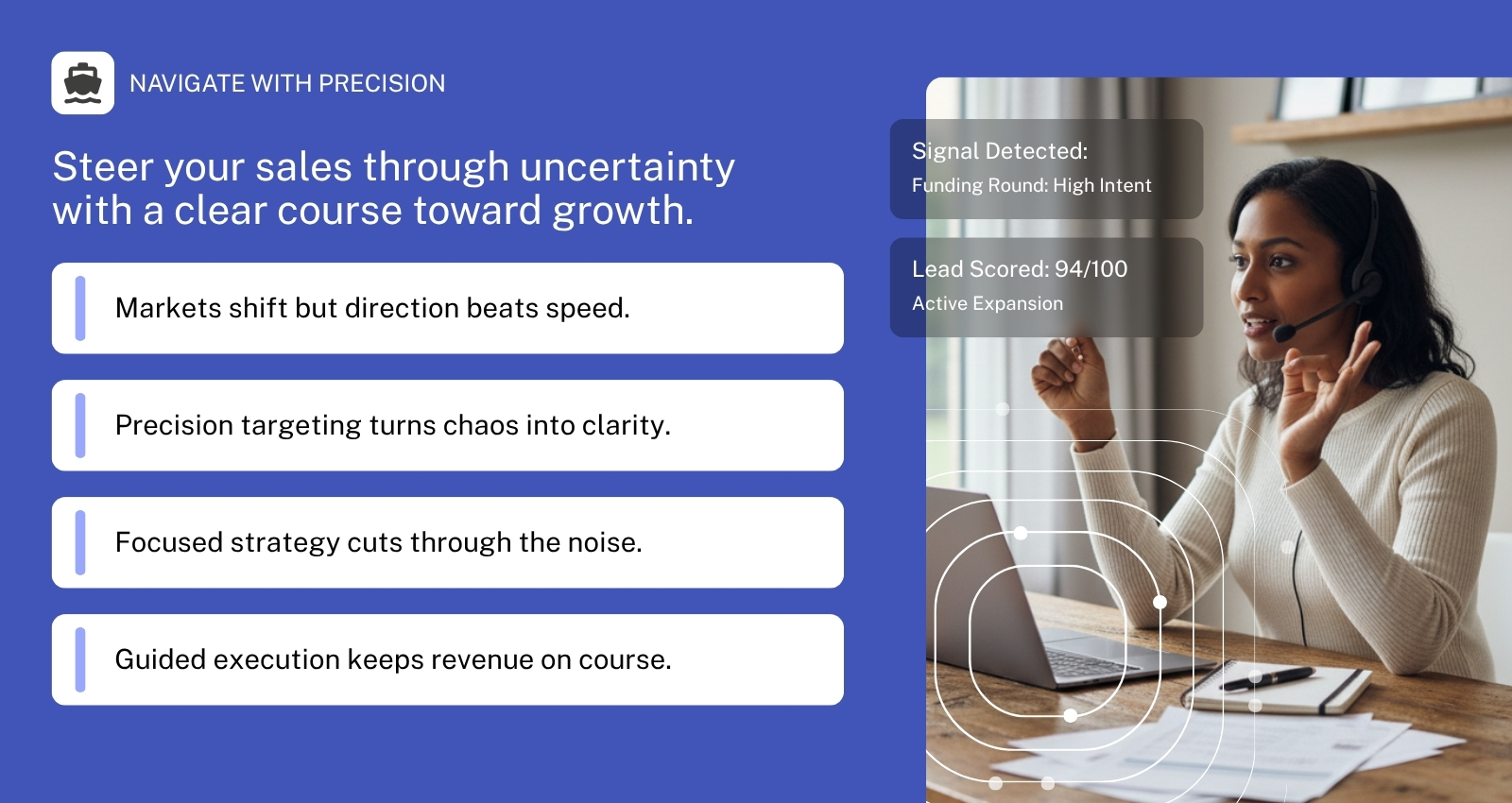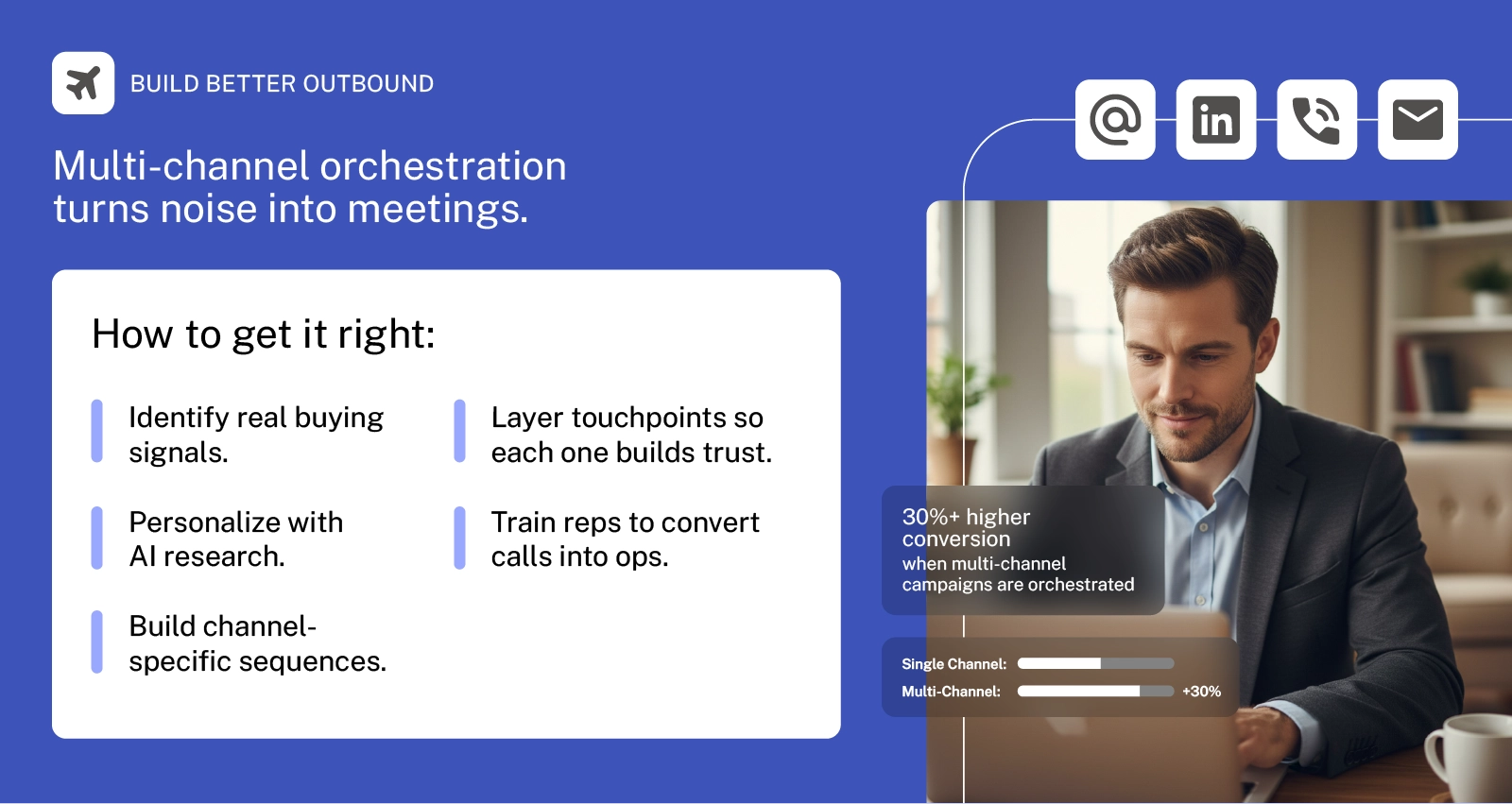

How to Become an SDR in 2025
[blog_at_glance]
Want to break into tech sales but don't know where to start? Becoming a Sales Development Representative (SDR) might be your golden ticket.
This guide breaks down everything you need to know about starting your SDR career, from must-have skills to daily responsibilities and growth opportunities.
Table of contents
- What is an SDR?
- Skills to Land an SDR Role in 2025
- The Path to Becoming an SDR
- Day in the Life of an SDR
- Career Progression
- Tools of the Trade
- The Future of SDR Roles
- Conclusion
What is an SDR?
Before we dive in, let's get real about what SDRs actually do.In general, modern SDRs are the critical first point of contact in the sales process, focusing on:
- Finding and qualifying potential customers
- Using multiple channels (phone, email, social) to connect with prospects
- Setting up meetings for Account Executives
- Gathering market intelligence
Essential Skills You Need to Land an SDR Role in 2025
Let's talk about what actually matters to hiring managers in 2025. Forget generic "good communication skills" – here's what you really need:
Must-Have Technical Skills
- Proficiency in CRM systems (Salesforce is king)
- Experience with sales engagement platforms (Outreach.io, SalesLoft)
- Data analysis capabilities (Excel/Google Sheets at minimum)
- Understanding of sales intelligence tools (ZoomInfo, LinkedIn Sales Navigator)
Critical Soft Skills
- Active listening (you need to actually hear what prospects are saying)
- Problem-solving (because no sales playbook covers everything)
- Resilience (rejection is part of the game)
- Time management (you'll be juggling multiple prospects and tasks)
The Real Path to Becoming an SDR: A Step-by-Step Guide
1. Education Requirements
Surprise – you don't need a fancy degree. While 65% of SDRs have bachelor's degrees, companies care more about your skills and hustle. What matters more:
- Sales certifications (HubSpot's Sales Training is a good start)
- Online courses in B2B sales
- Practical experience (retail, customer service, or any role dealing with people)
2. Building Your Foundation
Start with these concrete steps:
- Take a free HubSpot Sales certification
- Join sales communities on LinkedIn
- Follow sales leaders like Morgan J Ingram, Sarah Brazier and our very own Chris Muldoon.
- Practice mock sales calls - you can use an AI tool like ChatGPT for this
- Build a strong LinkedIn profile (this is your sales resume)
3. Getting Your First SDR Job
Here's what actually works:
- Target growing tech companies or SDR agencies like Punch!
- Connect with SDR managers on LinkedIn
- Demonstrate your research skills in your application
- Come to interviews with a 30-60-90 day plan
- Show metrics from any previous customer-facing role
A Day in the Life of an SDR: The Real Deal
Morning:
- 8:30 AM: Pipeline review and planning
- 9:00 AM: LinkedIn engagement (commenting, liking, sharing insights)
- 9:30 AM: Email outreach block
- 10:30 AM: Team stand-up
- 11:00 AM: Focus on high-intent leads
- 12:00 PM: Cold calling block
Afternoon:
- 1:00 PM: Social selling on LinkedIn
- 2:00 PM: High-priority prospect outreach
- 2:30 PM: Follow-up calls
- 4:00 PM: Administrative work and CRM updates
- 4:30 PM: LinkedIn networking and content engagement
- 5:00 PM: Next day planning
Pro Tip: According to Sales Hacker, top-performing SDRs spend 60% of their time on direct prospect outreach.
Career Progression: Where Can You Go From Here?
The SDR role is a launching pad, not a final destination. Here's what your career path could look like:
- SDR (1-2 years)
- Senior SDR/Team Lead (6 months - 1 year)
- Account Executive (2-3 years)
- Senior Account Executive
- Sales Manager or Account Manager
According to Bridge Group's latest research, the average time as an SDR before promotion is now 14 months, down from 16 months in previous years.
Tools of the Trade: What You Need to Master
Modern SDRs rely on a tech stack that includes:
- CRM: Salesforce, HubSpot Sales
- Engagement: Apollo.io, Orum, Salesloft
- Intelligence: ZoomInfo, LinkedIn Sales Navigator, 6sense
- Communication: Zoom, Gong, ChatGPT for message personalisation
- Analytics: Tableau, PowerBI, Revenue.io
- AI Assistants: ChatGPT, Claude, Harvey AI for research and outreach
The Future of SDR Roles: What's Coming in 2025
The SDR role is undergoing a fundamental transformation. According to Punch!'s 2025 B2B Sales Trends Report, the role is splitting into two distinct specialisations:
1. GTM (Go-to-Market) Engineers
- Focus on managing scalable, tech-driven outreach
- Leverage AI and automation for prospect research
- Master data analysis and tech stack integration
- Drive efficiency through digital selling techniques
2. Network Development Representatives (NDRs)
- Specialise in building deep, lasting relationships
- Focus on high-value, personalised outreach
- Create meaningful conversations through digital sales rooms
- Build strategic networks that generate long-term value
Key Evolution Points:
- Human-Centric Digital Sales: SDRs will use technology to enhance, not replace, human connections. Success will come from balancing automation with authentic engagement.
- Tech Stack Mastery: The emphasis is shifting from using many tools to mastering integrated solutions that deliver faster ROI.
- Data-Driven Approach: Modern SDRs must combine relationship building with sophisticated data analysis.
- Digital Sales Rooms: By 2026, 30% of deals will be run through digital sales rooms, requiring new skills in virtual engagement.
This evolution reflects a broader trend in B2B sales - the most successful SDRs will be those who can leverage technology to be more human, not less. The future isn't about choosing between being high-tech or high-touch; it's about being high-tech TO BE high-touch.
Conclusion: Your Next Steps
Ready to jump into your SDR career? Start with these immediate actions:
- Update your LinkedIn profile
- Complete a sales certification
- Start networking with SDR managers
- Practice your pitch
- Apply to growing tech companies
Want more insights?
- Download our comprehensive "B2B Sales Trends Report: 2025" to see what top industry leaders predict for the future of sales.
- Subscribe to the Punch!’s B2B Outbound Podcast where we break down winning strategies with top performers, share practical tips, and discuss real sales challenges.
- Scroll through our array of industry relevant blogs. We cover everything from cold calling techniques to advanced sales acceleration strategies.
Now get out there and start your SDR journey. The market needs good SDRs, and with these skills and strategies, you could be one of them.



“I focus on leading the direction of the business to maximise team efficiency and ensure client success”
[blog_at_glance]
Want to break into tech sales but don't know where to start? Becoming a Sales Development Representative (SDR) might be your golden ticket.
This guide breaks down everything you need to know about starting your SDR career, from must-have skills to daily responsibilities and growth opportunities.
Table of contents
- What is an SDR?
- Skills to Land an SDR Role in 2025
- The Path to Becoming an SDR
- Day in the Life of an SDR
- Career Progression
- Tools of the Trade
- The Future of SDR Roles
- Conclusion
What is an SDR?
Before we dive in, let's get real about what SDRs actually do.In general, modern SDRs are the critical first point of contact in the sales process, focusing on:
- Finding and qualifying potential customers
- Using multiple channels (phone, email, social) to connect with prospects
- Setting up meetings for Account Executives
- Gathering market intelligence
Essential Skills You Need to Land an SDR Role in 2025
Let's talk about what actually matters to hiring managers in 2025. Forget generic "good communication skills" – here's what you really need:
Must-Have Technical Skills
- Proficiency in CRM systems (Salesforce is king)
- Experience with sales engagement platforms (Outreach.io, SalesLoft)
- Data analysis capabilities (Excel/Google Sheets at minimum)
- Understanding of sales intelligence tools (ZoomInfo, LinkedIn Sales Navigator)
Critical Soft Skills
- Active listening (you need to actually hear what prospects are saying)
- Problem-solving (because no sales playbook covers everything)
- Resilience (rejection is part of the game)
- Time management (you'll be juggling multiple prospects and tasks)
The Real Path to Becoming an SDR: A Step-by-Step Guide
1. Education Requirements
Surprise – you don't need a fancy degree. While 65% of SDRs have bachelor's degrees, companies care more about your skills and hustle. What matters more:
- Sales certifications (HubSpot's Sales Training is a good start)
- Online courses in B2B sales
- Practical experience (retail, customer service, or any role dealing with people)
2. Building Your Foundation
Start with these concrete steps:
- Take a free HubSpot Sales certification
- Join sales communities on LinkedIn
- Follow sales leaders like Morgan J Ingram, Sarah Brazier and our very own Chris Muldoon.
- Practice mock sales calls - you can use an AI tool like ChatGPT for this
- Build a strong LinkedIn profile (this is your sales resume)
3. Getting Your First SDR Job
Here's what actually works:
- Target growing tech companies or SDR agencies like Punch!
- Connect with SDR managers on LinkedIn
- Demonstrate your research skills in your application
- Come to interviews with a 30-60-90 day plan
- Show metrics from any previous customer-facing role
A Day in the Life of an SDR: The Real Deal
Morning:
- 8:30 AM: Pipeline review and planning
- 9:00 AM: LinkedIn engagement (commenting, liking, sharing insights)
- 9:30 AM: Email outreach block
- 10:30 AM: Team stand-up
- 11:00 AM: Focus on high-intent leads
- 12:00 PM: Cold calling block
Afternoon:
- 1:00 PM: Social selling on LinkedIn
- 2:00 PM: High-priority prospect outreach
- 2:30 PM: Follow-up calls
- 4:00 PM: Administrative work and CRM updates
- 4:30 PM: LinkedIn networking and content engagement
- 5:00 PM: Next day planning
Pro Tip: According to Sales Hacker, top-performing SDRs spend 60% of their time on direct prospect outreach.
Career Progression: Where Can You Go From Here?
The SDR role is a launching pad, not a final destination. Here's what your career path could look like:
- SDR (1-2 years)
- Senior SDR/Team Lead (6 months - 1 year)
- Account Executive (2-3 years)
- Senior Account Executive
- Sales Manager or Account Manager
According to Bridge Group's latest research, the average time as an SDR before promotion is now 14 months, down from 16 months in previous years.
Tools of the Trade: What You Need to Master
Modern SDRs rely on a tech stack that includes:
- CRM: Salesforce, HubSpot Sales
- Engagement: Apollo.io, Orum, Salesloft
- Intelligence: ZoomInfo, LinkedIn Sales Navigator, 6sense
- Communication: Zoom, Gong, ChatGPT for message personalisation
- Analytics: Tableau, PowerBI, Revenue.io
- AI Assistants: ChatGPT, Claude, Harvey AI for research and outreach
The Future of SDR Roles: What's Coming in 2025
The SDR role is undergoing a fundamental transformation. According to Punch!'s 2025 B2B Sales Trends Report, the role is splitting into two distinct specialisations:
1. GTM (Go-to-Market) Engineers
- Focus on managing scalable, tech-driven outreach
- Leverage AI and automation for prospect research
- Master data analysis and tech stack integration
- Drive efficiency through digital selling techniques
2. Network Development Representatives (NDRs)
- Specialise in building deep, lasting relationships
- Focus on high-value, personalised outreach
- Create meaningful conversations through digital sales rooms
- Build strategic networks that generate long-term value
Key Evolution Points:
- Human-Centric Digital Sales: SDRs will use technology to enhance, not replace, human connections. Success will come from balancing automation with authentic engagement.
- Tech Stack Mastery: The emphasis is shifting from using many tools to mastering integrated solutions that deliver faster ROI.
- Data-Driven Approach: Modern SDRs must combine relationship building with sophisticated data analysis.
- Digital Sales Rooms: By 2026, 30% of deals will be run through digital sales rooms, requiring new skills in virtual engagement.
This evolution reflects a broader trend in B2B sales - the most successful SDRs will be those who can leverage technology to be more human, not less. The future isn't about choosing between being high-tech or high-touch; it's about being high-tech TO BE high-touch.
Conclusion: Your Next Steps
Ready to jump into your SDR career? Start with these immediate actions:
- Update your LinkedIn profile
- Complete a sales certification
- Start networking with SDR managers
- Practice your pitch
- Apply to growing tech companies
Want more insights?
- Download our comprehensive "B2B Sales Trends Report: 2025" to see what top industry leaders predict for the future of sales.
- Subscribe to the Punch!’s B2B Outbound Podcast where we break down winning strategies with top performers, share practical tips, and discuss real sales challenges.
- Scroll through our array of industry relevant blogs. We cover everything from cold calling techniques to advanced sales acceleration strategies.
Now get out there and start your SDR journey. The market needs good SDRs, and with these skills and strategies, you could be one of them.















